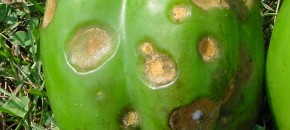As the summer heats up in New Jersey, the control of Phytophthora blight in cucurbit plantings can be extremely difficult (even with the use of fungicides) as hot, wet weather has set in these past few weeks. Mitigating losses to Phytophthora blight in cucurbit crops begins with long crop rotations, where recommendations suggest crop rotations […]
Continue reading...Vegetable Disease Update – 7/10/25
Cucurbit downy mildew has been reported (7/11/25) on cucumber in central New Jersey. For more information on CDM and its control please click here. Early blight has been reported in tomato. Bacterial leaf spot (BLS) has been reported in bell and non-bell pepper. For more information on BLS please click here. Tobacco Streak Virus and […]
Continue reading...Phytophthora and Pythium control during wet weather
Most of New Jersey has been wet making current conditions ideal for pathogens such as Phytophthora and Pythium. Unfortunately, Pythium cottony leak and Phytophthora blight can be found on most farms in the southern part of the state. Poor crop rotations with susceptible hosts only make matters worse. The Phytophthora pathogen has an increasing host […]
Continue reading...Bacterial leaf spot, copper resistance, hot water seed treatment, and viruses
Copper resistance in bacterial leaf spot of tomato and pepper crops has been detected at a high level in New Jersey the past few summers. While not surprising, copper resistance has been known to develop for decades now. Copper applications for the control of bacterial diseases in many crops has been a mainstay for decades […]
Continue reading...New Addendums for the USDA Harmonized and Harmonized Plus Audits
On July 3, 2025, the USDA Agricultural Marketing Service released 3 new addenda to the Harmonized and Harmonized GAP Plus+ Standards: Warehouse, Food Defense, and Integrated Pest Management. All of which will require additional records. Requirements in the existing Harmonized and Harmonized GAP Plus+ standards have not changed. These new standards, versions 3.1 and 5.1 […]
Continue reading...Preparing for Pepper Anthracnose in 2025

Pepper anthracnose caused by Colletotrichum spp. has become a significant problem on some farms in southern New Jersey. Unlike in tomato, where symptoms are only present in mature (red) fruit, pepper anthracnose can infect pepper fruit at any growth stage. Currently, there are no commercially-available bell or non-bell peppers with known resistance to anthracnose.
Continue reading...